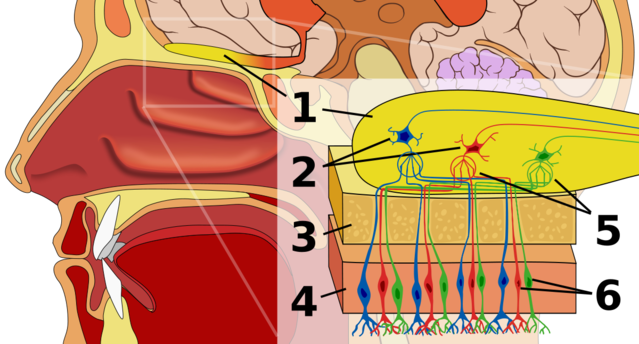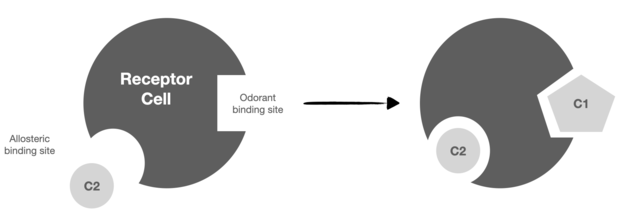Scent
When Perfumery Meets Molecular Science
Why odor mixtures are more than the sum of their parts.
Posted August 11, 2020 Reviewed by Abigail Fagan
It's challenging to think of two worlds as far apart as those of perfumery and neuroscience. Perfumery dabbles in the fleeting and transient appearance of smells. It creates sensory expressions of aesthetic imagery and subjective appeal. Neuroscience investigates the hard facts of molecular mechanisms and patterns of neural activity. It models how something works, not how it appears. The connection between these two areas of expertise seems far from intuitive. But there is one.
A recent study in the journal Science, led by Lu Xu of the Firestein lab at Columbia University, looked at the olfactory receptors in the nose (proteins that detect airborne chemicals in your environment and turn them into electrical signals for your brain to process; see figure).
They discovered an unusual pattern of behavior in these proteins — uncommon in comparison to other sensory systems, such as vision or touch. These observed patterns of receptor behavior could now explain some sensory effects long known in perfumery. Such effects, routinely cast aside as a somewhat quirky phenomenon in previous decades, may hold the key to understanding how the brain makes sense of scents.

What perfumers have known, and what scientists can now explain on a molecular level, is that odor mixtures do not behave additively. Additively means that you should be able to calculate what the sum of components will smell like from putting together its individual compounds. The visual system works additively. You can calculate colors by adding and subtracting ranges of electromagnetic wavelengths (which translate into colors in the visible spectrum of light), such as "pink is white light minus green." In contrast, olfactory mixtures are more than the sum of their parts.
Perfumers will tell you that every mixture is so chemically complex that it often behaves unpredictably. For example, you may put a small drop of a compound into a mix, and it changes the fragrance of the entire blend in an instant (not seldom in an unexpected way). The opposite can also happen. You may put tons and tons of drops of a compound into a mixture, and it doesn't change an iota of the overall fragrance. Olfactory scientists refer to these phenomena as enhancement and suppression effects. Specific odor notes of chemical compounds are either enhanced or suppressed when they occur in a mixture.
Instead of secret alchemical tinkering (turning skunk into rose smells or piss into mint), the roots of the erratic qualities of odor mixtures are biochemical. It all comes down to the patterns of receptors activated by the chemicals reaching the epithelium tissue in your nose. Which and how many receptor cells are activated by single compounds? And do the same receptors react when that compound is administered together with other compounds in a mixture?
To explore this question, the study utilized a new neuroimaging tool, developed by Elizabeth Hillman: SCAPE microscopy (SCAPE stands for Swept, Confocally-Aligned Planar Excitation ... now, try saying that fast five times in a row). This tool allows you to observe two things together: the behavior of individual cells on the one hand, and entire cell populations on the other — notably, in intact tissue and in real-time! So, you can spritz an odor over the nasal epithelium from a mouse and see which particular cells and how many different cells are activated (see video).
That kind of observation had not been possible before. "The obvious thing to do with this would be blends or mixtures to see the [olfactory] code," Firestein said.
Xu, the lead author, exposed epithelial tissues of genetically engineered mice (allowing for tracking active cells with fluorescent glow) to two mixtures, each consisting of three compounds. She tested how the cells responded to each compound when administered individually, in pairs, and then in the tripartite mix. She found that two things happened.
Some cells responded to individual compounds and further reacted to binary mixtures, but these cells remained quiet when exposed to the tripartite blend. That was not unexpected, per se. We know similar outcomes from other sensory systems as antagonistic effects, where one compound can block receptor cells such that they won't respond (or respond with reduced activity) to other elements. Here you have fewer cells responding to the entire mix than to the sum of its components. Such antagonistic interactions might explain why the odor quality of a compound can get lost in a mixture. It gets neutralized on the receptor level by other compounds in the mix.
Surprising was the other observed effect. In addition to antagonism were enhancement effects. Some cells did not respond to individual components but became active when exposed to the mixture. In other words, these cells would only react to compounds in combination but not to them individually.
What was happening here? "The modulation effect is not because of chemical reaction. These organic chemicals are chemically inert under our experimental conditions," Xu replied. Instead of chemistry, the data pointed to a biological explanation.
Enhancement effects suggest a molecular mechanism at the receptor level known from pharmaceutical studies. However, this mechanism had never been observed at the sensory periphery: allosteric modulation. Allosteric means that a receptor has a potential binding site that does not lead to its activation yet results in a change of its conformation (imagine you touched water and upon your finger reaching the surface it became ice). In this new confirmation, the receptor now is receptive to components to which it previously did not react (see image).

As an example: imagine a receptor that does not bind a particular compound C1. Then you put this compound in a mix together with the compounds C2 and C3. Compound C2 attached to the allosteric site of the receptor and changes its conformation. That leads to a modulation of its activation behavior such that it now responds to compound C1.
Such allosteric interactions are fascinating since they reveal why mixtures can adopt odor qualities that are different from their components' sensory qualities. In effect, you have entirely new cells responding to this mix, further introducing new signals for the brain to compute into odor images. That is where expertise in perfumery meets research in molecular biology.
Smell perception, traditionally, had been sidelined in mainstream science because it was thought of as somewhat irregular and subjective in its effects. However, these apparent irregularities often point us towards the molecular mechanisms that create our mental phenomena.
Olfaction, like any other sense, is governed by objective biological causes that link our scientific explanations to our perceptual experience. But, in comparison with other senses, olfaction also has a few unexpected molecular tricks up its sleeve.
References
Xu, L., Li, W., Voleti, V., Zou, D. J., Hillman, E. M., & Firestein, S. (2020). Widespread receptor-driven modulation in peripheral olfactory coding. Science, 368(6487).




